
Ecology (A-level biology)

Ecology
Overview
Ecology is the study of the relationship of living organisms with each other and their nonliving environment. The study of ecology lays a foundation for understanding agriculture, forestry, fisheries, conservation, the impact of human activities on the ecosystem, and how to remedy these impacts.
General objectives
By the end of the topic, the learner should be able to
- Describe the relationships of organisms with each other and their nonliving environment.
- Explain the impact of human on the ecosystem and the need for conservation
1. Components of the environment
Specific objectives
The learner should be able to
- Describe the abiotic components, (air, water. Soil) and biotic components (living things)
- State abiotic factors (light, temperature, humidity, atmospheric pressure, rainfall, edaphic facts) and biotic factors (competition, predation, and biological association)
- Explain how the components and environmental factors influence the distribution and abundance of organisms in an ecosystem.
Concepts in ecology.
Biosphere
The earth is the only planet on which life is believed to exist.
The part of the earth and its atmosphere inhabited by living organisms is called the ecosphere / biosphere. The biosphere is subdivided into large areas with different environment conditions called biomes. Largely, the biome is subdivided into terrestrial biome and aquatic biome.
Terrestrial biomes
The two most important environment variables for life on land are rainfalls and temperature.
Basing on these facts the terrestrial biome is further subdivided into;
(a) Tropical rain forests
These are formed whenever, it’s hot [24-280C ] and wet throughout the year. The vegetation of tropical rain forest has a distinctive structure, with very tall tree which project above the rest of the forest canopy, beneath these emergent is a second layer of large tree which, together with emergent make up a continuous canopy. A third tree layer is made up of smaller tree which complete their cycle without ever reaching the canopy. Still nearer the ground are young trees, palms vine and herbs. By the time sunlight reaches the forest floor, most of it has already been intercepted so that it’s dark with relatively sparse vegetation. Many organisms live in the canopy.

The leaves of the tree are tough and impossible for most animals to digest. The most successful leaf-eater in central and tropical South America are sloths.
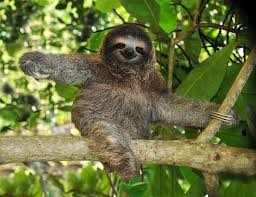
Adaption of the sloth to feed on leaves
– It eats a large amount of leaves to enable it extract as much food contents as possible.
– has long gut that allows enough time for digestion to complete
– contain mutualistic bacteria that digest cellulose
– Because of low energy content of leaves and necessity to conserve energy; the sloth.
* is a slow-moving animal which rely on camouflage for protection
*its temperature fluctuates, falling several degrees Celsius at night.
The soils of tropic rain forest are generally poor probably because decomposition occurs very quickly due to high temperature and any other available nutrient are rapidly taken up by plant or leached due to high rainfall.
(b) Temperate deciduous forest.
The north temperature zone lies between tropical of Cancer and artic cycle. The southern temperature zone lies between tropical of Capricorn and Antarctic cycle. In these two zones is where the temperature deciduous forest likely to be found, dominated by oak, hazel, beech

The major problem in this biome is that half of the year is winter when the temperature is too low for life. To survive in this condition, organisms have developed the following adaptations.
a. loss of leaves by the trees in winter to reduce on water loss by guttation.
b. small animals hibernate
c. birds migrate to tropics during winter
d. some animals have accumulated a lot of fast to prevent heat loss in winter
e. some have short life cycle in of 3-6 months and survive in a dormant stage in winter
(c) Desert
For example, Sahara Desert in Northern Africa is characteristic by scarce irregular rainfall and sandy soil.
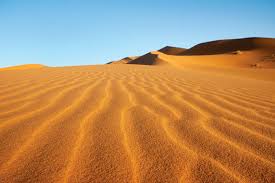
To survive in the desert organism have developed the following adaptations.
1. Small plants and animals have got very short life cycle; For instance, plants may germinate, mature, flower in a few weeks following occasioned rainfall, and then survive in form of seeds during the long dry spell.
2. To overcome shortage of water, the camel; use metabolic water and its body is very resistant to dehydration; certain frogs can survive for years without water by burying themselves deep into the sand. When it rains they dig themselves out, mate, and lay their eggs in shallow puddles. Here the tadpole grows very quickly, metamorphosing into adults before the puddle disappears.
3. The camel has got broad feet not to sink in the sand.
4. Some plant such cactus store water in their fleshly stems.
(d) Tandra
It occurs in northern Canada and Asia. It is characterized by long winter and very short growing season. For this reason, it contains no tree neither small mammals but plants with very short life cycle and bigger animals with a lot of fats deposits e.g., Reindeer
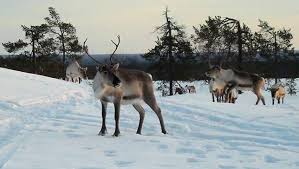
Aquatic biomes
Most important variable that affect organism which live in water are
- Salinity
- nutrient availability
- depth of water
- how permanent is the water body
- tide strength
Salinity
Aquatic organisms have got a problem of osmoregulation at different salinities. Consequently, organisms are only adapted differently to this problem in freshwater and marine water. And those that can survive in freshwater cannot survive in marine water and vice versa
Nutrient availability
The most important nutrient in water are the nitrates and phosphate. Lake with low phosphate and nitrate (oligotrophic) contain more species than lakes with high levels of nitrates and phosphates (eutrophic lakes)
In eutrophic lakes, the high levels of nitrates and phosphate promote high growth rates of algae and other photosynthetic organisms. This, in turn, supports a large number of aerobic bacteria that decompose the dead photosynthetic organisms. However, the aerobic bacteria take up more oxygen from water thus oxygen concentration may fall below that, can support the life of big organisms.
Depth of water
Shallow water may not be able to support big animals like whales. Small ponds may dry up which has a profound effect on the organism that can only survive in water.
Tide strength
Distribution of organism on the shores is affected tide strength; very strong tides, it prevents the growth of plant near the lake and big animals in water.
Factors that affect the distribution of organism on land.
Abiotic factors
1. Soil
It provides vital link between the biotic (living) and Abiotic (nonliving components) of the terrestrial ecosystem.
The term soil is applied to a layer of material overlying the rocks of earth crust. A suitable nutrient content and structure essential for successful growth and production in ecosystem.
Components
Soil contains mainly
| Component | Percentage of the soil |
| mineral salt (inorganic particle) | 50 -60% |
| Organic matter | Up to 10% |
| Air | 15 -25% |
| water | -35% |
Inorganic particles.
They are usually classified by the average size of particular shown below
| Particle diameter (µm) | Particular name |
| <2 | clay |
| 2 – 20 | silt |
| 20 -200 | fine sand |
| 200- 2000 | coarse sand |
| 2 – 20 mm | gravel |
Soil that contains a mixture of sand, clay, silt. Loams soil a mixture sand and clay soil in equal proportion with hummus is the best soil for plant growth.
Physical properties of sand, clay soils are summarized below.
| Properties | sand | clay |
| Texture | coarse | fine |
| Structure | light | heavily |
| Aeration | good | poor |
| Drainage | fast | slow |
| Water retention | poor | good |
| Nutrients | poor | good |
Air and water
Water and air occupy the same space therefore the soil that contains more air will contain less water and vice versa. Aeration is the term used to describe the amount of air in the soil. Drainage is the ability of water to go through the soil. Oxygen is particularly required for the respiration of microorganisms and plant roots; decomposition of organic matter, germination of seeds, root hair formation, growth, and water absorption.
Soil water is important
- As a source of water and dissolved mineral salt for plants.
- Promotes seed germination
- Excess water (waterlogging) slows down water absorption (by lowering the respiration of plant roots since it displaced air from the soil) and decay.
- Water softens soil for easy root penetration
Organic matter
Dead organic matter is derived from soil organisms and from organism that live above the soil surface. Fungi and bacteria in the soil decompose organic materials to humus. Humus improves the water retention in the soil and therefore the soils containing humus will resist leaching.
- Soil organism.
The soil organism range in size from bacteria and protoctist to fungi, Nematode, insect, worms, and a few mammals such as screw:
Role of soil organism
- Microorganisms such as bacteria and fungi.
- Promote germination by breaking seed coats
- Fix nitrogen in the soil
- Decompose and recycle or organic matter
- Macro-organisms such as rodents, termite, and worms turn the soil and improve aeration and drainage
- Promote decay by breaking big pieces into small pieces
- When they die they decay and add humus to the soil
Dissolved minerals
The nature of dissolved minerals in the soil depends on the parent rock, organism growing in and above the soil and whether aerobic conditions prevail chalk soil, for example, are high in calcium carbonate. However, soils with low concentrations in phosphate, nitrogen, and iron, have high species diversity.
When soils are waterlogged, ions capable of existing in either oxidized or reduced state are found in their reduced form. Fe 2+, for instance, occurs instead of Fe3+ some plants are very sensitive to Fe2+, so the vegetation found on waterlogged soil differs from vegetation in well-drained condition
Soil pH is the acidity or alkalinity of the soil. It usually lies between 3 and 8.
Effect of soil pH
- Acidic soil with pH of less than 4.5 reduces the availability of nitrogen and phosphorus to plant, on the other hand,
- the concentration of toxic Al3+ ions increases as the pH falls. These two factors enable a few plants to grow in acid bogs. Those that do are often carnivorous and this supplies them with extra nutrients.
- Affect the activity of microorganism which may increase to reducing the rate of decay and nutrient recycling
Soil Structure
This is the arrangement of soil particles, it refers to the looseness or compactness of the soil particle.
Its effects are
- Drainage for loose soil is faster than that of compact soil
- Erosion for loose soil is faster
- Aeration is higher in loose soil
- Soil temperature.
- High soil temperature increases the rate germination, decay, absorption of water
Climate
Climate refers to the predictable long-term pattern of rainfall, temperature, and light. Weather is more short term. It may be cold, windy, and wet one day and warm, calm, and dry the next.
Water
In general, water is necessary for life. For terrestrial organisms, annual rainfall is the most important variable. However, it’s predictability and pH are also important organism living in dry places usually have a specialized mechanism to reduce water loss.
For aquatic organisms, the temperature, salinity, oxygen saturation, and nutrient content of the water are vital. In addition, the wave action limits the distribution of many aquatic species.
In the river the rate of current flow is important. It is noticeable that free-floating aquatic plants are absent from most streams and rivers but widespread in lakes and ponds
Temperature.
Few organisms can grow if the ambient temperature falls outside the range 0 -400C though, remarkably, some thermophilus bacteria can complete their entire life cycle at a temperature in excess of 1000C.
Light
Light is needed for photosynthesis in plants and vision in animals. Light can vary in its wavelength, intensity and daily duration and these can affect the quality of life.
Effects of light on living organisms
- Photosynthesis in plant
- Photoperiodic behavior in plants i.e. influence flowering in plants
- Phototropism
- Phototaxis
- Vision in animals
- Migration of animals
- Reproduction
Air.
One of the most important components of air is oxygen and few organisms can live without it. CO2 is a reagent in photosynthesis
Relative humidity
This the measure of the amount of water vapor in the air. When its low organism loses water through evaporation and therefore face the risk of dehydration, on the other hand, if it’s very hot and humid, a low rate of evaporation may be harmful as evaporation serves to remove heat from an organism and so cool it down.
Wind.
- Occasional stormy wind can flatten trees that are 100 years old.
- Continuous strong wind can prevent trees from becoming established.
- Wind serves a useful function in the pollination and seed dispersal in plant
- Migratory birds may use winds to minimize.
Fire
Fire can only burn if the organic matter has accumulated. Nowadays fire is often the result of human carelessness. Natural fires are caused by lightning strike or more rarely by volcanoes
Ecological effect of fire
- kill slow animals & plants
- some animal migrates
- encourage soil erosion &leaching
- release poisonous gases
- encourages regeneration in some grasses e.g. Cymbopogon
- destroys or chase away vectors, pests and parasites, e.g. tsetse flies
- accelerates nitrogen recycling of plastic waste.
- Allow growth of fire-resistant species which are often not palatable.
- Destroys humus
Topography
By topography is meant the altitude, slope, and aspects of a place. As one climbs a mountain, many features of the physical environment change. It may be cold, wetter, and windier. The air gets thinner so that oxygen and carbon dioxide become scarcer and more ultraviolet light penetrates. Slope is important because it reduces the chance of becoming waterlogged. On a very steep slope, soil cannot form, so plants cannot establish themselves.
The aspect of a place is of most importance to sessile (immobile) organism. In the northern hemisphere, south-facing slopes receive more light and heat energy than north-facing ones. The reverse is the case in the southern hemisphere. This influences the distribution of plants in the wild.
Population and niche concept
Population.
A population is group of individuals of the same species in a defined area. The number of individuals in a population is called the population size e.g. all Tilapia living in a lake, all fleas on a dog, lion (in a national park). It is important to estimate the population in a given area,
Importance of estimating the population size
- To be able to construct food webs and chains, the pyramid of numbers, biomass, and energy
- To understand the existing food relationship within a habitat.
- To observe population changes with time/seasons so as to understand the way populations affect each other at different environmental factors.
- To know the population of pests in order to work out control methods.
- For management purpose i.e. Plan for cropping programs in game and national parks.
- To value and conserve biodiversity/ natural reserves/ wildlife and national parks.
- To understand the dispersal/spread of organisms
- To understand the impact of populations in the environment.
Estimating population size.
Factors to be considered to select a method to be used.
- Size of the organism e.g. big organisms such elephants are easily counted directly
- Mode of the organism such as
- motility; plants and the sessile or slow-moving organism may be counted directly,
- while indirect methods may be required for the fast-moving organism in large open grassland
- Association between organism- some methods such as capture-recapture method requires organisms that associate randomly.
- Hostility hostile organisms may require special gadgets for collection and/or counting.
3. Size of the area under investigation. For big areas, the population may be estimated based on samples
4.Physical and climatic factors
5. Climatic condition
6. Topography
7. Nature of vegetation
Methods for estimation of population size of large animals living in unconcealed habitats, e.g. Antelopes, Hippopotami, lions etc.
(i) Direct counting method using a low flying aircraft.
Basic requirements are: an aircraft, survey map of the area and a counter
Procedure
The aircraft is flown on a transect section of the area of a known dimension and the animals in each transect are counted. The aircraft is then flown back along another adjacent transect and counting continues until the whole area is covered. Several counts are made and an average is determined. The estimated population in a given unit area is determined.
Advantage
- The method gives a quick estimate of the population of animal in an area.
- It can also be done concurrently with studies on other aspect of population like feeding habits
- It reduces the risk of attack from aggressive animals
- It reduces the risk of counting the same organism more than once
- There is no disturbance to the environment.
Disadvantage
- It is sophisticated and expensive
- Aircraft may scare away some animals to be counted
- It cannot be applied to small animals in concealed habitats such as a forest.
- It is greatly hampered by climate; i.e., cannot work in cloudy or mist climate.
(ii) Aerial photography
Basic requirements are aircraft and good camera
Procedure
Photographs are taken from a low flying aircraft usually on a scale over the whole study area. Photographs are developed and animals counted from the photographs. As in the direct counting method, a population density is a given number per unit area
Advantages and disadvantages are similar to those for direct count using an aircraft
(iii) Drive and count
In this method, animals are driven by a number of people into a particular spot and counted.
Advantage
- it reduces the chances of counting animals more than once
- gives accurate results
Disadvantage
- it can’t be used on aggressive animals
- it is tedious on fast-moving animal
- it is difficult to apply to animals that do not live in herds.
(iv) Strip census
In this method animals are counted a long path while walking or in a vehicle. The population density of an area is determined as the number per unit area (of strips)
Advantage
It gives a quick estimate of the animal population of an animal
It is cheap
Disadvantage
- Some animals such paths and are unavailable for counting
- People of vehicle may scare away the animals
- Fist moving animals may be counted more than once
(v) Direct counting (Census)
Large organisms that are not aggressive and are living in open habitat e.g. buffaloes, Elephants and trees in the forest are counted one by one.
Advantage
- Quick and accurate
- More than one population can be estimated at the same time
- Other aspects of an organism’s ecology, behavior can be taken at the same time.
- There is minimal disturbance to environment.
Disadvantage
- It may be difficult to count overcrowded organisms, e.g. flock of weaverbird.
- Some organisms avoid being seen.
- Difficult to use on animals that concealed in their habitat.
- Bad weather may affect visibility and hence the count.
- Does not take into account the immigrants
- Tedious
Determining the population of small animals
(i) Quadrat
Suitability: plants, immobile or easily caught animals
This a small area marked out for study. A quadrat flame (1m2) is thrown randomly and the number of organisms within the number of quadrats that represent a known fraction of the total area determined to estimate the total number in the whole area by simple proportion multiplication.
This method provides a means of calculating three aspects of distribution.
- Species density. The number of organisms per unit area; limitation. It’s time-consuming to count each and every individual in a quadrant
- Species frequency; This is a measure of the probability [chance] of finding a given species with anyone throw of a quadrat in a given area. The limitations are quadrat size, plant size, and spatial distribution [random, uniform or clumped].
- Specie cover; This is a measure of the proportion of the ground occupied by the species and gives an estimate of the area covered by the species as a percentage of the total area. The limitation; it’s slow and tedious.
Advantage of quadrat method
- Accurate
- Enable the comparison of different areas and species
- It does not have to be completed over a short time
- It reduces the chances of counting the same individual twice
- It is possible to estimate populations of more than on species at the same time
Disadvantage
- In practice animals are not randomly distributed therefore random plots may give inconsistent results.
- Not appropriate for large area
- Not applicable in water and concealed habitat
- Time-consuming to do well/tedious
- Causes some level of disturbance to the environment
- Not suitable for fast-moving organisms
Assumptions
- the quadrats are chosen randomly.
- The organisms do not move from one quadrat to another
- The samples taken are representative of the population as a whole
- The population is uniformly distributed
Reliability of the quadrat method depends on
- The population of each quadrat must be known exactly
- The area of each quadrat should be the same shape
- The quadrate size must be appropriate for the organisms being sampled.
(ii) Capture-recapture or mark-release methods.
Here a sample of individuals is caught, counted, and marked in some ways. Then these individuals are released.
After being allowed to mix with the rest of unmarked population a second sample is caught and the number of marked individuals noted. An estimate of population size can then be made from.

Precautions for capture-recapture methods
- The organism should mix uniformly within the population.
- Sufficient time must elapse between capture and recapture to allow uniform mixing.
- There must be no emigration and immigration to the specified area.
- Making does not hinder the movement of organisms or make them conspicuous to predators.
- Marking should be permanent.
(iii) Removal method
The removal method is very suitable for estimating the number of small organisms particularly insects, within a known area of grassland or volume of water. Using a net in some form of standard sweep; the number of animals is recorded and the animal kept. This procedure is repeated a further three times and gradually reducing number of organisms recorded. A graph is plotted of the number of animals captured per sample against the previous cumulative number of animals captured. By extra plotting the time of the graph to the point at which no further animal would be captured (that is the number in sample = 0) The total population may be estimated, e.g.
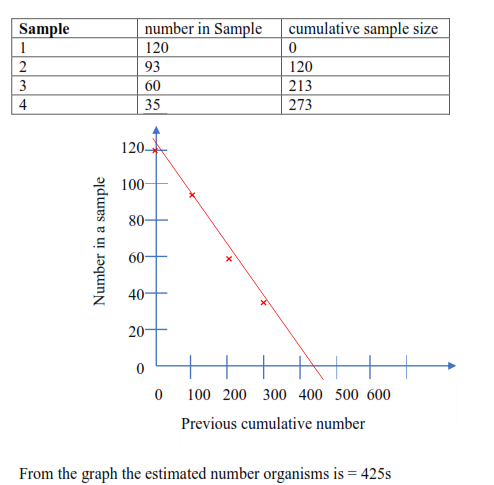
Population growth and growth curves
Populations grow and decline in characteristic ways. The size of the population increase will be determined by the reproductive potential of the organism concerned and by environmental resistance.
A Plot of the number of individuals against time gives a growth curve.
Two basic forms of growth curves can be identified by the J-shaped growth curve and the S- shaped or sigmoid growth curves.
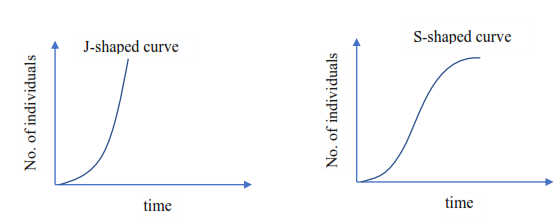
The S-shaped or sigmoid growth describes a situation in a new environment:
- initially, the population density of an organism increases slowly because there is a shortage of reproducing individual which may be widely dispersed as it adapts to new conditions and establishes itself;
- then increases rapidly, approaching an exponential growth rate. During this growth phase there are optimal environmental conditions- No environmental resistance, birth rate exceeds death rate.
- It then shows a declining rate of increase until a zero-population growth rate is achieved where the reproduction (natality) equals rate of death (mortality), The declining rate of increase reflects increasing environmental resistance, which become proportionately more important at higher population densities. In other words, as the number increase, the competition for essential resource such as food or nesting materials, increases until eventually feedback in terms of increasing mortality and reproduction failure [fewer mating, stress-induced abortion] reduces population growth to zero with natality and mortality in approximate equilibrium.
The J-shaped growth curve describes a situation in which, after the initial phase (lag phase) population growth continues in an exponential form until stopped abruptly, as environmental resistance becomes suddenly effective.
In very general terms the J- shaped growth form may be considered an incomplete sigmoid curve where a sudden limiting effect comes into play before the self- limiting effect within the population assume importance.
The maximum population of an organism that a particular environment can sustain is termed the carrying capacity. This is identified theoretically as the k-value [or upper asymptote] of the sigmoid curve
Factors that affect the size of the population
The number of individuals in a population is affected by four factors; birth, deaths, immigration and emigrations. The change in the size of any population over a period of time can be summed by the equation. Change in the population size = B+I- D- E where
B=birth, I= immigration, D=death and E=emigration.
Environmental resistance
The form that the environmental resistance takes depends on the species in question.
Here are the main factors that limit population growth
- lack of food or water
- lack of light
- lack of oxygen
- predator and parasites
- Disease
- lack of shelter
- Accumulation of toxic waste e.g. CO2 and nitrogenous waste
- stress in some case overcrowding may excess stress leading to abnormal behaviors. E.g., Female rats kept in capacity at a high population density show a breakdown in normal maternal behavior, failing to build adequate next and abandoning their young ones.
It has even been argued by some biologists that in the wild the males of some species of small mammal die prematurely as a result of excessive stress.
- Weather and catastrophes. Weather conditions and generally may drastically reduce the population. The effect is perhaps most severe for the small organisms, but in a particularly bad winter even large species may show significant decline in population size
- Predator-prey relationship; The population of the prey is usually high when that of the predator is low. That of the predator increase with the population of the prey [which provide food]
Survivorship curves
Ignoring for the moment immigration and emigration, birth, and death are the two processes that affect population size. However, these processes depend on the age of individuals and on their sex. The crucial factor is the chance of an individual has of surviving to a given age, This can be shown by means of survivorship curve, To understand a survivorship curve, image a population of 100 individuals borne at the same time. The curve shows how many of them are likely to be alive at any particular age. There are three main types of survivorship curve and these are shown below;
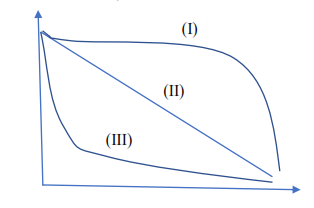
Curve (I) is typical of organism such as ourselves that have few young ones. After an initial period of low juvenile mortality, mortality is very low until late in life
Curve (II) is found in many small birds, notice that as the vertical axis is logarithmic, the curve actually shows an exponential decline in the number of individual surviving overtime. The individuals do not die of old that is, there is no senescence.
Curve III The lower curve is typical of many plants and fish. Thousands or millions of young are produced, few of which mature into adults. The vast majority die as juveniles.
The niche concepts
In 1934 a biologist called G.F. Gause published a book called the struggle for existence. In it he included the results of careful experiments he had carried out on two species of paramecium, a unicellular ciliate. Gause found that he could easily keep Paramecium caudatum and P. Aurelia. in separate containers in his laboratory. However, when he tried to keep the two species in the same container, P. caudatum always died out, after a few days. Gause’s results were put into a general statement called the competitive exclusion principle.
This states that two species cannot co-exist unless there are significant differences in their ecologies. In the case of Gause’s two species of paramecium, their ecologies are similar.
Nowadays Gauss’s competitive exclusion principle is sometimes stated as follows; ‘Each species has its own unique niche’. The niche of an organism is what an organism does in its community. Niches are sometimes distinguished from habitats [spatial address] because the niche of an organism describes it’s location and function [address and profession with a particular community or ecosystem. There is a notation of the fundamental niche of an organism as opposed to its realized niche. The fundamental niche is the niche a species would occupy in the absence of any competitors, predator or parasite. The niche that the species actually occupies, on the other hand, is called it’s realized niche.
Association between species
There are many situations in which organisms form close associations with one another. Such association may occur with the same species [intraspecific associate] or between different species interspecific influenced by the presence of the other.
Intraspecific associations, such as communication, mating behavior, form the basis of social organization.
Intimate associations
Intimate associations are found when the body of one organism called the host, acts as the habitat for another organism. The host may be habitat in or on which the organism can survive or reproduce, in which case the association is described as obligatory. If the host is not essential, the association is described as facultative. The general term used to describe the intimate association between pairs of species is a symbiosis which loosely translated from the Greek means ‘living together’. Some older books restrict the terms symbiosis to cases where the association benefits both species. However, most ecologists nowadays use symbiosis in its wider sense and divide the term into three categories distinguished by the consequence of the association to each party.
Parasitism;
A parasite is an organism that lives on or in another organism from which feed. A parasite that lives on the surface of its host is called an ecto-parasite and that lives inside it’s called an endoparasite. Most species, including human, harbor parasites that reduce their health and may cause death.
Challenges faced by a parasite
- Locating a new host
- Overcoming host rejection
- Entering a host
Parasitic adaptations
Parasite show many different adaptations of overcoming these challenges, depending on whether they are ecto-parasites or endo-parasites.
- Many endoparasites show degeneration, or even total loss of certain organs which reduces their energy and material requirements and hence a reduced burden on their host. For example, gut parasites like the tapeworms lack an alimentary canal.
- Many parasites especially ectoparasites have attachment devices such as sucker, hooks, or anchors enabling them to cling to the host. Tapeworm has hooks and suckers to anchor on the host digestive canal.
- Some parasites have penetrative devices for gaining entrance into the host and its cells. For example, miracidum larva of the liver fluke has a slender tip on to which open a group of glands which secrete tissue- digesting enzymes. By softening the tissue, the enzyme enables the larva to bore into the foot of a freshwater snail the intermediate host.
- Gut parasite live in a particularly hazardous environment. They typically have protective device which protects their being harmed by the host’s digestive processes. These devices include the possession of a thick protective cuticle, the secretion of large quantities of mucus and the production of inhibitory substances which locally inactivate the host’s digestive enzymes.
- To protect themselves from the host’s immune system, some parasites such as the blood fluke, schistosoma, that cause, bilharzia, synthesizes chemicals, which switch of the host’s immune system; The parasite coat’s itself with molecules which the host recognizes as self.
- Parasite overcome a problem of moving from one host to another by a number of strategies, one of which is to wait until the host mates. The various organism responsible for sexually transmitted diseases in human spread in the same manner
- Many parasites employ a secondary or intermediate host which conveys the parasite from one primary host to another. Thus, the Anopheles mosquito transfers the malaria parasites from one person to another.
- To raise the probability of success vast number of offspring are produced
- The parasites may have a dormant resistant stage in its life cycle to survive adverse conditions until a suitable host is found.
- Some parasites are closely linked with their host that their tissues are actually interconnected.
E.g., certain plant parasites such as mistletoes plug into other plants and tap off nutrients from the host’s tissue.
Exercise
Which one of the following characteristics of a parasite is not a means of ensuring the continuity of the species of the parasite?
A. Degeneration of redundant body structures.
B. Means of penetrating another organism.
C. Protection against host enzymes.
D. Means of dispersing offspring
The answer is A
Degeneration of redundant body structures is an adaption of a parasite to its mode of life but does not directly ensure continuity of its species.
Note : some of the adaption of a parasite that ensures continuity of the parasite species include
- Possession of penetrative devices for gaining entrance into the host.
- Possession of protective devices which prevent the parasite from being harmed by the host’s digestive processes. For example, gut parasites inhibitor substance which inactivate the host’s digestive enzymes.
- Having a means of dispersing its offspring. For example, employing a secondary (intermediate) host which disperses the parasite over a wide area.
- Producing a large number of offspring to increase the chance of success in getting from one host to another as is the case in a parasitic fungus and malaria (plasmodium) parasite
- Production of chemicals that protect some parasite against the host’s defense mechanisms.
Commensalism
This is a relationship between two organisms. One of the two organisms, the commensal benefits from the association, while the other organism usually the larger partner, neither lose nor gain.
Mutualism
Here the association benefit both the participant, i.e., the gain is mutual. E.g. lichen is an association between a fungus and an alga. The fungus absorbs water from atmosphere while an alga photosynthesizes for both.
Predation
In this relationship in which one organism lives the other dies instantly. For example lion, the predator kills the zebra (prey) instantly.
Communities and ecosystems
On this plant no one can exist without another, Human depend on one another and the surroundings. Without plants, animals would starve through lack of food and in the long would run out of oxygen. Without bacteria and fungi, decomposition and nutrient cycling would stop. In the absence of animals, many plants would be unable to reproduce.
Communities
This a sum of all living organism found in a specified. Species within a community interact with each other, sometimes these interactions benefit both species. For example. The fruit produced by the plant supply birds with food, however, the birds disperse the seeds of these fruits which benefits the plant.
Ecosystem
An ecosystem is a self-sustaining unit consisting interacting organisms in an area together with the non-living constituents of their environment. For example, an oak wood ecosystem consists of living organisms such as trees and animals and the physical environment such as rain, the inorganic components of soil, sunlight, and atmospheric oxygen and carbon dioxide.
Succession
This is the change of community over a period of time or the replacement of some species by others through time.
Primary succession
It begins with a bare rock where there is no form of organic matter. Usually, the first organism (pioneer community) to colonize a bare rock is the lichen followed by mosses and ferns, big plants and animals as organic matter accumulate. It must be noted that the first organisms to colonize a bare rock must be photosynthetic.
Secondary succession
Occurs when the surface is completely or largely stripped of vegetation but has already been influenced by living organism and has an organic component. For example, a cleared forest or a previously burned or farmed area. Seeds and pores and organs of vegetative reproduction, such as rhizomes, may be present in the ground to influence the succession.
The climax community is often described as having one dominant [those with the greatest collective biomass or productivity] or several co-dominant species
Zonation
This is the spatial distribution of species with a community according to variations of physical environment. An example of zonation is the vertical zonation that occurs on mountains with increasing altitude superficially zonation may resemble succession, but it is important to recognize the basic differences, names that with zonation the species vary in space[spatially], whereas with succession the species vary in time [temporally]
Productivity and biomass
- Gross primary production is the total organic material made by photosynthesis in a specified time s known as the.
- Net productivity is the amount of organic material produced by synthetic organisms actually available to the herbivores since part of gross primary production is respired or decomposed transferred to herbivores or carried downstream.

The percentage of the energy at one trophic level which ends up in the next trophic level is called the trophic efficiency. The trophic efficiency of the herbivores, for instance, equals the percentage of the net primary production that is converted to the herbivore production [i.e. to growth and reproduction of herbivores
Lindeman in 1942 proposed that succession involved increase productivity until a climax community was reached in which the maximum efficiency of energy conversion occurred.
Evidence shows that the latter stages of succession do not become productive, but that there is usually a decline in the gross productivity associated with the climax community. This older forest which in turn may have lower productivity than young forests, which in turn have lower productivity than the more species-rich herb area.
The reason for the decrease in production can only be speculated upon but using a forest as an example, older trees might be expected to be less productive than younger trees for several reasons. One is that the accumulation of nutrients in the increasing standing crop biomass may lead to a reduction in nutrient recycling. However, a simple reduction in vigor as the average age of the individuals in the community increases to a constant point would presumably cause a reduction in productivity.
Succession also leads to a maximum accumulation of biomass. This is most obvious in the case of the forest community, where the plants become larger and larger during succession, but the accumulated biomass of other climax communities is also normally greater than in the successional stages. Changes in gross productivity, respiration and biomass during a typical succession and summarized on the graph below.
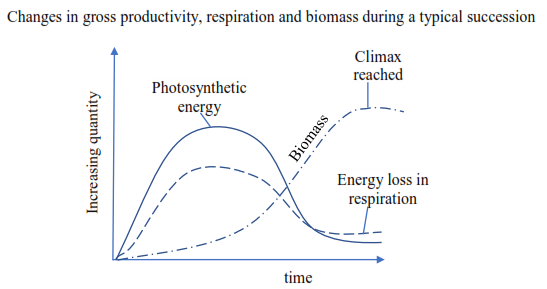
This shows that in climax community these terms become more or less constant. It also shows that an upper limit of biomass is reached when total respiratory losses [R] from the system almost equal gross primary productivity [P], i.e. P/R = 1
During a succession more and more of the available nutrients become locked up in the biomass of the community with a consequent decrease in nutrients in the abiotic component of the ecosystem [such as soil and water] the amount of detritus produced increases and detritus feeder take over from grazers as the main primary consumers. Appropriate changes in food webs occurs and detritus becomes the main source of nutrients
Example
Which one of the following equations shows the correct relationship between gross primary productivity (GPP) and net primary productivity (NPP) in plants?
A. GPP = NPP – photosynthesis.
B. NPP = GPP – photosynthesis.
C. GPP = NPP – plant respiration.
D. NPP = GPP – plant respiration
Answer is D
Productivity of a plant is the rate at which energy is stored in the producers in the form of organic substances.
Gross primary productivity (GPP) is the rate at which chemical energy derived from the sun is stored by the plants.
Net primary productivity (NPP) is the net gain of organic material in photosynthesis after allowing for losses due to respiration
That is
NPP = GPP -plant respiration
Cycling of matter and flow of energy in the ecosystem.
In almost all ecosystems, the organisms fall into three nutritional groups.
- producers
- Consumers
- Decomposers
These are related as follows;
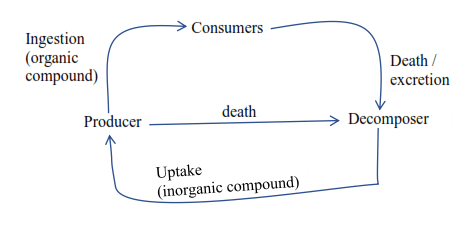
Organic material synthesized by the produces are eaten and assimilated by the consumers, All the organic materials incorporated into the bodies of the consumers are eventually broken down into inorganic materials. These are then rebuilt into organic compounds by the synthesis activity of the producers.
Although matter circulates repeatedly around an ecosystem, this is not the case with energy. Instead, energy is continually lost from the ecosystem as heat energy. The photosynthetic producers transfer some of the radiant energy of sunlight to chemical energy in plant carbohydrates. By their respiratory activities the producer, consumer, and decomposers transfer this energy to ATP, whose subsequent hydrolysis provides energy for the cells’ vital activities. Both in the formation of ATP and subsequent usage, a proportion of the energy is lost from an ecosystem as heat energy. Ultimately all the energy in an ecosystem is transferred to heat energy. However, the continual trapping the energy of sunlight by green plants compensate for this loss and maintains the flow of energy.
Nutrient cycle.
In order for the organism to maintain themselves, grow and reproduce, they need a supply of elements of which they are made. These they regenerate from the cycling of matter or nutrient cycle.
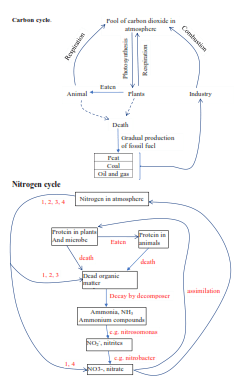
Nitrogen fixation process in order of magnitude.
- industrial fixation e.g., Haber process
- mutualistic blue-green bacteria e.g., Rhizobium e.g. legume
- free-living blue-green bacteria e.g. Azobacter, clostridium
- Action of lighting etc. on oxygen and nitrogen.
7. Which of the following is the correct sequence representing the action of nitrifying bacteria?
A. Nitrites — nitrates — ammonium salts.
B. Ammonium salts — nitrites — nitrates.
C. Nitrites — ammonium salts — nitrates.
D. Ammonium salts — nitrates — nitrites.
Energy transfer; food chains and trophic levels.
Within the ecosystem the energy-containing organic molecules produced by autotrophic organisms are the source of food [material and energy] for heterotrophic organisms; a typical example is a plant being eaten by an animal. This animal may, in turn, be eaten by another animal, and in this way, energy is transferred through a series of an organism, each feeding on the preceding organism and providing raw materials and energy for the next organism. Such a sequence is called a food chain.
Definition
A food chain is a sequence of organisms with arrows pointing from organisms being eaten to an organism that eats it.

Each stage of the food chain is known as a trophic level, the first trophic level being occupied by the autotrophic organisms, the primary producers. The organism of the second trophic level are called primary consumer, those of the third level is secondary consumer, and so on. There are usually four or five trophic levels and seldom more than six because;
-There simply not enough energy in the ecosystem to support more than this number of steps. As it is, top carnivores often have to roam over huge areas to find enough food.
-It is difficult to imagine a species with the hunting abilities necessary to feed on eagles, loins, killer whales or any other existing top carnivores,
-The more levels in the food chain the less stable it becomes.
Food webs
Is feeding relationship showing organisms feeding on more than one organisms.
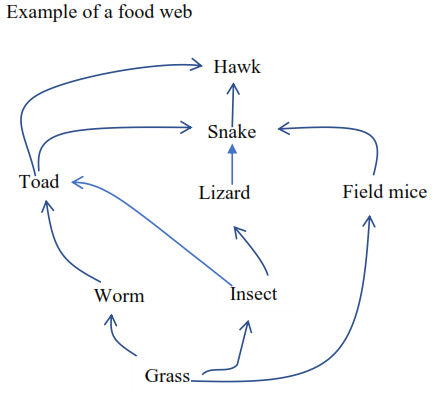
Ecological pyramids
Food webs give a useful description of the feeding relationships in a community. However, they are non- quantitative. Feeding relationship and energy transfer through the biotic component of ecosystem may be quantified and shown diagrammatically as ecological pyramid. These give an apparently simple and fundamental basis for comparing different ecosystem, or even seasonal or variation of pollution-induced charged with a single system.
Pyramid of number
These are pyramid drawn base on the number of the organism in each tropical level it’s based on ideology that preys are usually smaller and more numerous than their predators.

However, the pyramid of numbers, despite their name, need not always be pyramidal in shape. Consider the situation where a single very large producer, such as a tree, supports a large number of primary consumers. In this case an inverted pyramid of numbers results.
Inverted pyramids of numbers can also result when a community contains parasites. Imagine for instance, a mammal infected with tick or fleas. These parasites are in a trophic level above the mammal, yet their numbers will be greater. Some of the inverted pyramids of numbers are shown below.
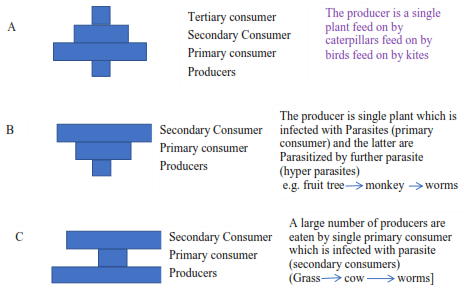
Pyramid of biomass
This a type of ecological pyramid based not on numbers but biomass. Here instead of counting the number of individuals at each trophic level. The total mass (biomass) of organisms at each level is measured. The rectangles used in constructing the pyramid then represent the masses of organisms at each trophic level per unit area or volume. The greatest mass is usually found with the producers, but the measurement of the biomass at the various trophic levels in the community may also give an inverted pyramid. For instance, at certain times of the year, the biomass of the tiny herbivorous organisms that float in lake and oceans (zooplankton) may exceed the biomass of the tinny photosynthetic organisms (phytoplankton) on which they feed. This is because biomass refers to the mass of organisms present a particular moment, the so-called standing crop. At this time of the year, phytoplankton is able to support the zooplankton due to the high rate of turnover than that of zooplankton.
Pyramid of energy
This is the most fundamental and ideal way to represent the relationship between organisms in different trophic levels. A pyramid of energy shows the transfer or flow of energy through a community. As a result, pyramids energy is expressed in units of energy per area per time e.g., kilojoules m-2yr-1. A generalized pyramid of energy is shown below.

Consequently, the number of trophic levels in a food chain or the length of the food chain is limited by the energy wasted as it is transferred from the organism, i.e. by the efficiency of energy transfer between trophic levels
Other factors are the availability of sufficient food of the preferred types and territorial space
Rational cropping of ecosystems
Cropping is the removal of an organism from an ecosystem for food, whether plant or animal. Rational cropping is using the ecosystem to produce food in the most efficient way. This may mean increasing productivity of the crop and decreasing the effects of disease and predation by animals, or by using a crop that is better adapted to conditions in the ecosystem.
Increasing productivity of plant crops may be achieved by adding fertilizer to the soil, and by adding water to the soil by irrigation or removing water by drainage, as necessary.
The disadvantage of carrying out these processes is that over a long period of time, the use of manmade fertilizers can lead to deterioration of the soil structure which will eventually lead to a decrease in productivity, and the addition of fertilizer or water is often energy- expensive. Decreasing the effects predation, generally insects and birds in case of plant crop and disease is usually carried out by the selection of resistant genetic strains of the crop or the use of chemicals to kill the pest or disease-producing organisms. Using such chemicals must be done with care; Persistent chemicals, those not rapidly broken in an ecosystem may have disastrous effects on other trophic levels and effective pesticides used too frequently may bring about an outbreak of resistant strains of the pests which are more difficult to control.
Pollution and conservation
Pollution is the damaging release by humans of materials and energy to the environment than can be removed by the environment. The materials or energy released are called pollutants.
The pollutants may be biodegradable or non-biodegradable. Biodegradable pollutants like sewage are broken down by micro-organism to harmless substances fairly quickly, whereas non-biodegradable pollutants cannot be so readily broken down. They tend to accumulate and are therefore potentially more dangerous. Below are specific examples
Carbon dioxide
Accumulation of carbon dioxide (from burning fossil fuel, deforestation, etc.) contributes to global warming or the greenhouse effect. The greenhouse is a slow progressive increase in the average temperature of the earth over a period of time.
The effects of global warming
- Melting of ice on mountain tops and earth pole leading to floods
- Droughts in subtropical latitude (5-350N)
Means of reducing carbon dioxide concentration in the air
- Using alternative source of energy other than fossil fuel such as solar electricity or nuclear energy
- More energy-saving measures could be introduced.
- Massive tree-planting programs to lock up carbon dioxide in the wood
- Nutrient enrichment of the oceans might allow huge algal blooms which would trap carbon dioxide in organic matter.
Oil pollution
Oil pollution results in spillage from the petroleum carrying ship. When inevitable accidents happen or when oil refineries are bombed during the time of war. Oil being lighter than water, floats on sea, killing birds and other animals it may also prevent photosynthesis by blocking carbon dioxide.
Methods of treating oil pollution include
- Setting fire on the oil
- Pumping the oil back into special oil collecting ship
- Adding naturally occurring bacteria that can digest oil
- Adding special spill cleaners that are relatively nontoxic and biodegradable than previously used detergents.
Damage to the ozone layer
Ozone, O3, is found at low concentration in the earth’s stratosphere, 15 to 50km up. Here it protects the earth from dangerous radiations that out damage the cell genetic material leading to cancers. Ozone layer may be damaged by chlorofluorocarbons (CFCs)used as coolants in refrigerators
Pesticides
Pests are organisms that people consider a nuisance or harmful. Pesticides are substances that kill pests.
Challenges of using pesticide
- Non-biodegradable pesticides accumulate in plants and animals causing death
- Indiscriminately kill organisms including useful ones including useful ones
- Prolonged use may lead to the resurgence of resistant strains of pest.
Acid rain
Acid rain is due to releases of acidic gases such as sulphur dioxide (SO2) and nitrogen dioxide (NO2) usually from unregulated industries. Low pH of acid rain is damaging to organism tissues. It causes skin corrosion and contributes to the destruction of forests in Europe and Northern America.
Sewage is the water-borne waste of society. It includes both domestic and industrial sewage.
Domestic sewage contains human feces and urine, water used to wash these away and dirty water flow from our baths and sinks.
Industrial sewage includes dirty water from industry, hospital, and abattoirs.
Agricultural sewage is not allowed to mix with domestic and industrial waste and is treated separately.
If untreated sewage or agricultural fertilizers are allowed to enter lakes or rivers, eutrophication may occur. Eutrophication is the enrichment of water with nutrients such as nitrogen and phosphorus. This leads to an overgrowth of algae (or algal blood) which use up oxygen in water leading to the death of fish. Death of fish leads to over multiplication of aerobic decomposers, cause further depletion of water oxygen and death of fish.
Radiation from radioactive substances leads to death and/or injury of people and animals by causing cancers.
Conservation
This involves managing the earth so as to restore and maintain a balance between the requirements of humans and those of other species.
There are two main reasons why we should conserve.
- The ethical reason is that we have a moral duty to look after the environment.
- The pragmatic argument says that it is to our advantage to ensure the integrity of our environment. If we preserve the tropical rain forest, the greenhouse effect will be lessened; if we conserve fish stock, we get more food from seas, etc.
Pest control
- A good pesticide has three properties:
- It must be specific
- It must remain for a short time in the environment i.e. easily transform to a non- toxic form
It must kill the designated population only or should be specific.
For revision questions and answers download PDF below
Please find free downloadable notes, exams and marking guides of agriculture, biology, and chemistry from digitalteachers.co.ug website.
Dr. Bbosa Science

Thanks so much Mr Bbosa,we appreciate you for the good work
wow, awesome blog. Cool.
Your content is consistently great. Garden & Outdoor
Fantastic job on this article. Keep it up! Indian Cricket